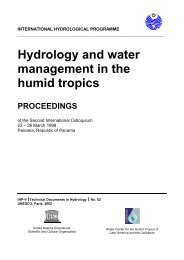FR AB - Science Reference
FR AB - Science Reference
FR AB - Science Reference
You also want an ePaper? Increase the reach of your titles
YUMPU automatically turns print PDFs into web optimized ePapers that Google loves.
shared research equipment. When asked if current<br />
funding for the SIG Program was adequate, 42 percent<br />
of the respondents responded that it was not.<br />
A smaller fraction of the respondents (26 percent)<br />
felt that the current level of support for the SIG budget<br />
was adequate. Survey respondents expressed<br />
even more dissatisfaction over the funds available for<br />
shared equipment not covered by the SIG program<br />
(instruments costing less than $100,000 involving multiple<br />
users). In this case, 55 percent of the respondents<br />
did not believe that “the level of funding support<br />
from NIH was adequate” and only 17 percent of<br />
the researchers supported this statement. Consistent<br />
with these findings, the survey respondents placed a<br />
high priority on having NIH increase the level of funding<br />
for research equipment. A majority of them (65<br />
percent) indicated that increased funding for equipment<br />
and equipment-related categories should be one<br />
of the top priorities in an expanding federal research<br />
budget. In contrast, only 13 percent of the respondents<br />
disagreed with this position. Consistent with this perception,<br />
survey respondents also placed a very high<br />
priority on increased funding for new specialized research<br />
equipment within their own research laboratories.<br />
For shared equipment and resources, respondents<br />
indicated that NIH should invest more funds in<br />
establishing new resource facilities employing emerging<br />
technologies.<br />
The overall perception of the survey respondents<br />
was that equipment and equipment-related needs<br />
were unmet and represented a serious problem in the<br />
extramural research community. Data from the survey<br />
indicates that NIH should invest additional funds to<br />
meet these needs.<br />
RECOMMENDATIONS<br />
• FASEB recommends that NIH increase its level of<br />
support for shared equipment costing $100,000 or<br />
more to $150 million per year for FY2001 with<br />
appropriate incremental increases thereafter.<br />
• FASEB recommends that NIH increase its level of<br />
support within the context of existing grant mechanisms<br />
such as R01s and P01s for equipment costing<br />
less than $100,000 to $50 million per year for<br />
FY2001.<br />
These amounts actually reflect the minimum<br />
funding requirements that exist in the biomedical<br />
research community because the survey results were<br />
extrapolated to only the NIH R01-population and do<br />
not capture the needs of investigators supported by<br />
other NIH funding mechanisms or non-NIH funded<br />
scientists.<br />
INSTRUMENTATION NEEDS<br />
FASEB also proposes that an expanded SIG program<br />
be improved by:<br />
• Decreasing the time from receipt of application to<br />
award from the current approximately one year to<br />
six months.<br />
• Increasing the number of review cycles from one<br />
to three per year.<br />
• Raising the caps to at least $1 million to authorize<br />
the purchase of more expensive equipment and<br />
to compensate for inflation pressures.<br />
• Allowing applicants to bundle two or more unrelated<br />
pieces of equipment that together cost more<br />
than $100,000.<br />
• Providing support for a maintenance agreement<br />
for up to three years if included in the instrument<br />
purchase price.<br />
• Permitting the establishment of facilities using<br />
components rather than strictly commercial instruments.<br />
• Using standing rather than ad hoc study sections<br />
for reviewing SIG grant proposals so that consistency<br />
in the review process is maintained.<br />
• Selecting peer reviewers with adequate expertise<br />
in emerging technologies.<br />
THE SHARED INSTRUMENTATION<br />
GRANTS PROGRAM<br />
For almost twenty years, the Shared Instrumentation<br />
Grant (SIG) program has allowed scientists to obtain<br />
equipment and equipment-related items that would<br />
be too expensive to purchase with research project<br />
grant funding. In existence since 1982 and administered<br />
by the National Center for Research Resources<br />
(NCRR), the SIG program has provided researchers<br />
with grants ranging between $100,000 to $500,000 to<br />
procure state-of-the-art instrumentation. Instruments<br />
purchased with SIG funds must be shared by at least<br />
three National Institutes of Health (NIH)-supported<br />
researchers.<br />
The budgets of the SIG Program have not kept<br />
pace with the expansion of biomedical research in the<br />
1990s. SIG awards totaled $32.5 million per year in<br />
1990 and 1991, with no appreciable growth in program<br />
funds since 1985. In 1992, SIG funds were reduced<br />
to $8.8 million and did not rise above $10 million<br />
per year until 1996. Only in 1999 did the SIG<br />
budget return to the 1990 level. But the 1999 budget<br />
for SIG grants ($34.2)—after adjusting for inflation—<br />
had less purchasing power than the 1990 budget. In<br />
2000, the SIG budget rose to $43.1 million. But when<br />
expressed in 1990 dollars ($30.3 million), it is still<br />
below the purchasing power of the program in 1990.<br />
JOURNAL OF BIOMOLECULAR TECHNIQUES, VOLUME 11, ISSUE 4, DECEMBER 2000 167















